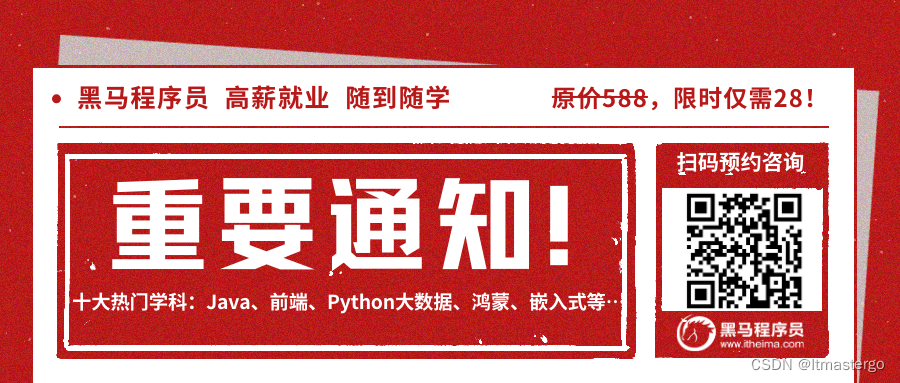一、简介
Java注解(Annotation)是一种元数据,提供了一种将数据与程序元素(类、方法、字段等)关联的方法。注解本身不改变程序的执行逻辑,但可以通过工具或框架进行处理,从而影响编译、运行时的行为。
二、注解的作用
1. 提供信息给编译器:可以使用注解检查错误或抑制警告。
2. 编译时处理:生成代码、XML文件等。
3. 运行时处理:通过反射在运行时进行动态处理。
三、注解的基本概念
1. 内置注解:Java提供了一些常用的标准注解,如@Override、@Deprecated、@SuppressWarnings。
2. 元注解:用于注解其他注解的注解,如@Retention、@Target、@Inherited、@Documented。
3. 自定义注解:用户可以根据需求定义自己的注解。
四、常用内置注解
1. @Override
- 用于标注方法,表明该方法重写了父类的方法。
@Override
public String toString() {return "Hello, World!";
}
2. @Deprecated
- 表示某个元素(类、方法等)已过时,不推荐使用。
@Deprecated
public void oldMethod() {// 不推荐使用的方法
}
3. @SuppressWarnings
- 用于抑制编译器警告。
@SuppressWarnings("unchecked")
public void test() {List rawList = new ArrayList();
}
五、元注解
1. @Retention
- 表示注解的保留策略。
RetentionPolicy.SOURCE:注解只在源代码中保留,编译时被丢弃。RetentionPolicy.CLASS:注解在字节码中保留,但在运行时不被保留。RetentionPolicy.RUNTIME:注解在运行时保留,可以通过反射获取。
@Retention(RetentionPolicy.RUNTIME)
public @interface MyAnnotation {
}
2. @Target
- 指定注解可以应用的元素类型,如类、方法、字段等。
@Target(ElementType.METHOD)
public @interface MyAnnotation {
}
3. @Inherited
- 表示注解可以被子类继承。
@Inherited
@Retention(RetentionPolicy.RUNTIME)
@Target(ElementType.TYPE)
public @interface MyInheritedAnnotation {
}
4. @Documented
- 表示使用此注解的元素应包含在Javadoc中。
@Documented
@Retention(RetentionPolicy.RUNTIME)
@Target(ElementType.METHOD)
public @interface MyDocumentedAnnotation {
}
六、自定义注解
自定义注解可以根据实际需求定义,包含成员变量和默认值。
1. 定义注解
import java.lang.annotation.*;@Retention(RetentionPolicy.RUNTIME)
@Target(ElementType.METHOD)
public @interface MyCustomAnnotation {String value() default "default value";int number() default 0;
}
2. 使用注解
public class MyClass {@MyCustomAnnotation(value = "test", number = 42)public void myMethod() {System.out.println("Hello, World!");}
}
3. 处理注解
可以使用反射获取并处理注解。
import java.lang.reflect.Method;public class AnnotationProcessor {public static void main(String[] args) {try {Method method = MyClass.class.getMethod("myMethod");if (method.isAnnotationPresent(MyCustomAnnotation.class)) {MyCustomAnnotation annotation = method.getAnnotation(MyCustomAnnotation.class);System.out.println("value: " + annotation.value());System.out.println("number: " + annotation.number());}} catch (NoSuchMethodException e) {e.printStackTrace();}}
}
七、常见注解框架
1. JUnit
- 单元测试框架,常用注解有
@Test、@Before、@After等。
@Test
public void testMethod() {// 测试代码
}
2. Spring
- 依赖注入和面向切面编程框架,常用注解有
@Component、@Autowired、@RequestMapping等。
@Component
public class MyService {
}@Autowired
private MyService myService;
3. Hibernate
- ORM框架,常用注解有
@Entity、@Table、@Id、@GeneratedValue等。
@Entity
@Table(name = "users")
public class User {@Id@GeneratedValue(strategy = GenerationType.IDENTITY)private Long id;private String name;
}
八、注解处理工具
1. Annotation Processor
- 编译时注解处理器,允许在编译期间生成代码、检查注解等。
@SupportedAnnotationTypes("com.example.MyAnnotation")
@SupportedSourceVersion(SourceVersion.RELEASE_8)
public class MyAnnotationProcessor extends AbstractProcessor {@Overridepublic boolean process(Set<? extends TypeElement> annotations, RoundEnvironment roundEnv) {for (Element element : roundEnv.getElementsAnnotatedWith(MyAnnotation.class)) {// 处理注解}return true;}
}
2. 反射
- 运行时处理注解,通过反射API获取注解并进行处理。
public class ReflectionExample {public static void main(String[] args) throws Exception {Method method = MyClass.class.getMethod("myMethod");MyAnnotation annotation = method.getAnnotation(MyAnnotation.class);if (annotation != null) {System.out.println("value: " + annotation.value());}}
}
九、实际案例
以Spring框架中的注解为例,展示如何通过注解进行依赖注入和控制反转。
1. 定义注解
Spring提供了@Component、@Service、@Repository等注解,用于标记组件类,@Autowired用于自动注入依赖。
@Component
public class MyComponent {public void doSomething() {System.out.println("Doing something");}
}@Service
public class MyService {@Autowiredprivate MyComponent myComponent;public void performTask() {myComponent.doSomething();}
}
2. 配置扫描
Spring配置类或XML文件中启用组件扫描。
@Configuration
@ComponentScan(basePackages = "com.example")
public class AppConfig {
}
3. 使用Spring应用上下文
创建Spring应用上下文并获取Bean。
public class Main {public static void main(String[] args) {ApplicationContext context = new AnnotationConfigApplicationContext(AppConfig.class);MyService myService = context.getBean(MyService.class);myService.performTask();}
}
十、注解的优缺点
优点
- 简化配置:注解可以减少XML配置,提高可读性和可维护性。
- 类型安全:注解在编译时进行检查,避免了运行时错误。
- 灵活性:通过注解可以方便地扩展和修改功能。
缺点
- 过度使用:滥用注解可能导致代码难以理解和维护。
- 依赖特定框架:不同框架的注解不通用,导致代码耦合度高。
- 反射开销:运行时处理注解需要使用反射,可能影响性能。
Java注解是一种强大的元数据机制,可以用于提供编译器信息、编译时生成代码、运行时动态处理等。通过内置注解、元注解和自定义注解,可以实现灵活的功能扩展。常见的注解框架如JUnit、Spring、Hibernate等广泛使用注解简化配置和编码。理解和合理使用注解,可以提升代码的可读性、可维护性和灵活性,但也需注意避免过度依赖和滥用。
通过实际案例和代码示例,可以更好地掌握注解的使用方法和原理。未来的开发中,注解将继续发挥重要作用,帮助开发者编写高效、优雅的Java代码。
黑马程序员免费预约咨询





)














